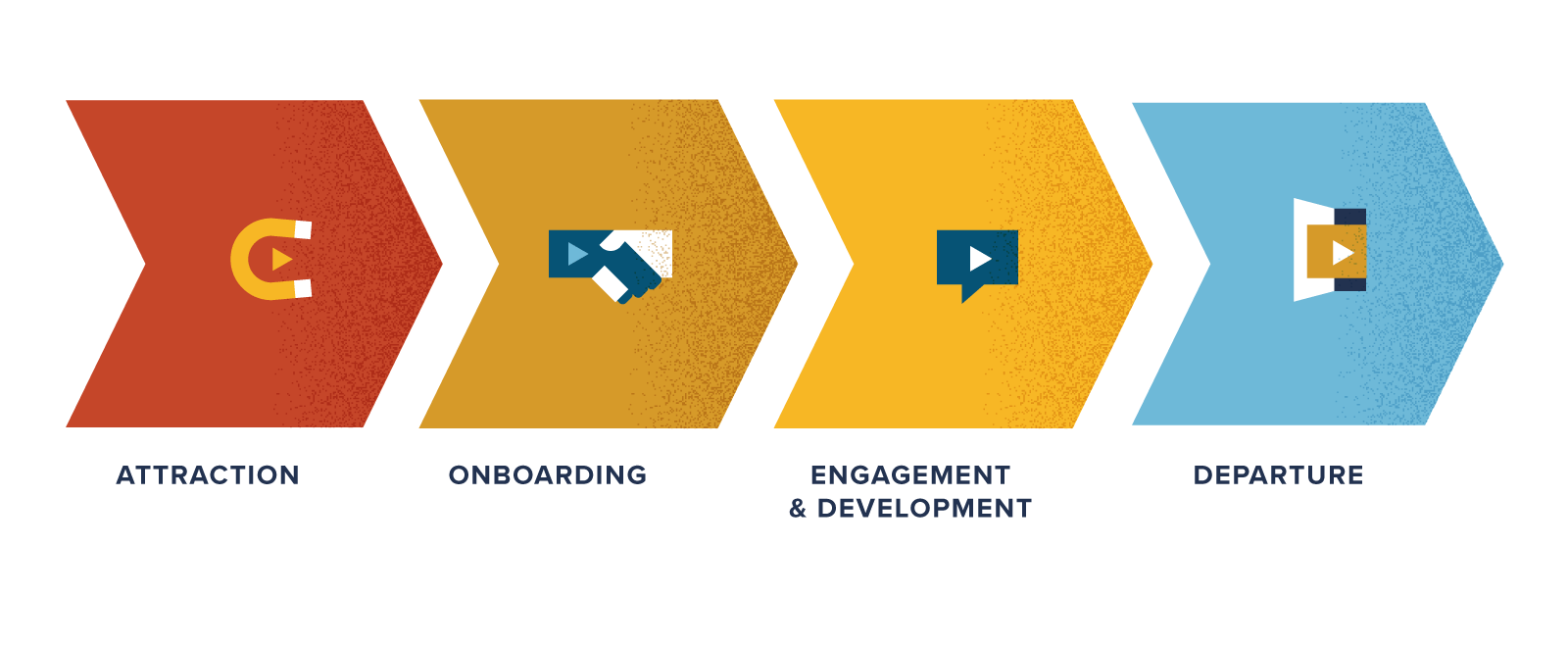
Workers are attracted to and respond better to, videos. So incorporate them throughout the entire employee journey to keep them engaged.
What’s the Problem?
There’s been a lot of focus on employee experience (EX) over the past few years. Some view it as a necessary step in the evolution of HR’s responsibilities. But not a lot of companies are ready for the transition (1). One reason for this hesitancy could be that it’s seen as such a huge undertaking. After all, that kind of commitment involves looking at the entire employee life cycle, vetting and acquiring new digital tools, measuring employee engagement, delivering on-demand training, not to mention allocating time and resources so that HR teams can do these tasks repeatedly. That’s asking a lot. HR teams need to find a way to ease their transition into a more digital EX. Incorporating videos throughout the employee journey can be that crucial first step.
Why Video?
It’s almost become a cliche to mention how much online video has taken over the internet. But studies show that workers are attracted to, and respond better, to video in a corporate setting as well. Whether it’s for recruitment, onboarding, or training video is proving to be an essential part of an HR communicator’s toolbox. One way to make sure you’re using video effectively is to map out your company’s employee journey. Then identify where and what type of videos would be helpful at each stage.

Using Gallup’s map of the employee journey as a starting point, let’s see how videos can enhance the employee experience at four key stages.

Attraction
Millennial and Gen Z candidates increasingly rely on video to discover and vet potential employers. In fact, according to HR Technologist, CareerBuilder reported job postings that included videos (indicated by a video icon) saw 12% more views than those without (4). Competition for top talent is high considering the relatively low unemployment rate and a shortage of critical skills in the marketplace, so using video helps you stand out.
“…modern candidates want to connect with your employer brand through video, and you have 1 minute 36 seconds (on average) to tell your story.”
–– Chiradeep BasuMallick(4)
The types of videos that could help at this stage are:
Recruitment/office culture videos
Typically these are shot on-site so that candidates get a true sense of where they would be working and who they would be working with. Authenticity and tone are the most important aspects of these types of videos. But there are still high expectations for its production value. If you’re not hiring professionals to shoot this, make sure to invest in good editing and music choices as those can lift the video’s quality if you’re not confident about your camera work. For example, check out this video by The Shoe Company interviewing multiple employees to share their personal experiences with the company.
Video Job Descriptions
These consist of interviews with a relevant team member who can speak intelligently about the job requirements and expectations. The goal, of course, is to make your company, and the job, as attractive as possible, but these can be produced quite easily and inexpensively. A smartphone on a tripod in a well-lit room might be all the equipment you need.
For example, check out this Salesforce video job description, created by Ongig, outlining the expectations for an Account Executive.
“In global outsourcing leader Alexander Mann Solutions’ experience, jobs ads with video generate 50% more applicants and a substantial increase in the job qualification of candidates who apply. Both firms say video job descriptions reduce cost per hire by reducing media spend on paid job ads. In addition, social videos generate 1200% more shares than text and images combined.”
– ModernHire
If you’re new to this approach to talent acquisition, there are vendors like Ongig, Cammio, and SkillScout who specialize in creating and maximizing job description videos.

Onboarding
Getting new hires up to speed quickly while helping them feel like part of the team is one of the most important HR responsibilities. Even more so if they’re working remotely as more American workers are inclined to do (9). Relying solely on in-person or on-paper onboarding sessions is inefficient not to mention almost impossible to scale. Videos, on the other hand, are proving to be the most cost-efficient, scalable, and effective way of welcoming new hires and evoking a sense of community, while covering the essential benefits and procedures material. How you use videos at this stage of the employee journey is up to you, but a few notable milestones to consider are:
Initial welcome message
Typically given by leadership, but ideally includes coworkers to create a sense of community and instill a sense of pride and purpose. You could send these out prior to their first day at work to get them excited about their new job.
For example, this EPA Welcome video creates a sense of community by using multiple employees to say “Welcome to the team.”
Explanation of benefits, policies, and perks
these cover the standard need-to-know information for working with your company and, as a result, tend to be the longest ones. Using a video platform that allows you to break the material up into shorter videos, or even chapters, makes it more manageable for the already overwhelmed new hire.
Explanation of Job-specific skills
if there is any proprietary knowledge that a new hire needs to know to get their particular job done right, giving them a heads up about it, and a resource they can access whenever they need it, will definitely help with their learning curve.
Office Orientation
Sometimes it’s the little things that can make getting used to a new workplace difficult. Creating quick orientation videos that cover how to navigate their future office space and technology can go a long way in easing any “new kid at school” anxieties.
For example, this video from Bernhardt Wealth Management gives viewers the lay of the land so new hires can be familiar with the environment from day one.

Engagement & Development
Once that fresh new hire smell has worn off, employees are still looking for continual communication with their employers. The goal at these stages is to help employees stay engaged by developing new skills and reinforcing a sense of purpose in their work. A few ideas for how videos can help are:
Celebration Videos
These could be quick, simple videos shot on coworkers’ phones or created from a template to celebrate a milestone or particular achievement. Workers, especially top performers, need to be validated, and distributing a video applauding their contribution to the team goes a long way toward making them feel valued.
“Three in 10 U.S. employees strongly agree with the fourth engagement element [receiving recognition]. By moving that ratio to six in 10 employees, organizations could realize a 24% improvement in quality, a 27% reduction in absenteeism and a 10% reduction in shrinkage.”
State of the American Workplace, Gallup
For example, Call4Health had its CEO record a message of appreciation for his staff.
Training videos
Invest in ongoing training materials that work with their schedules and give them control over the direction and pace.
“…more than two-thirds of the employees who answered our survey let us know that they’d rather use video to learn a new task than have to rely on written instructions.”
– Rachel Maltese, – Survey Results, Employees Prefer Video Training
Learning and Development Promotions
Employees won’t take advantage of available career development opportunities if they don’t know about them. Include videos (e.g. thumbnails or banners in emails or on the company intranet) with any promotional material you create to improve their chances of seeing it.
“What’s the best way to raise awareness about learning programs? Develop a full-production video with all the bells and whistles; or simply use your smartphone to make a quick video of your CEO sharing thoughts on why learning is important. Either way, you’re sure to get the attention of learners and inspire them to learn.”
– Linkedin Learning Workplace Training Report
Peer-to-Peer Knowledge Sharing
Don’t miss out on expertise hiding within your organization. Empower coworkers to create their own training videos covering specific on-the-job skills unique to their situation.
“The employees creating the training content would also have the opportunity to realize the value of their own skills, boosting their confidence and, down the road, their achievement. Additionally, this type of employee empowerment is likely to lead to greater workplace satisfaction and loyalty as they can see their impact on office culture and processes.”
– Jeff Rubenstien
Benefits Explainers
These videos can break down benefits options and changes in a clear, succinct manner. With some elements of interactivity, like quizzes or questionnaires, the videos could serve as decision-support tools to help employees feel better about their choices as well.
“94 percent of the employees who viewed a video took some action after doing so, including logging into the online enrollment software and accessing benefits information”
– Joanne Sammer
Leadership Town Halls
Whether by the CEO or other higher-ups, facilitating a two-way conversation between employees and leadership shows that transparency is a company value. Although these videos are typically live-streamed, it’s also a good idea to record them for company archives.
“…send an internal email or a recording of the event is a core follow up activity to ensure that everyone, including those who didn’t attend, has received a summary of the key messages that were conveyed in the town hall.”
– Andrea Duke

Departure
Offboarding Videos
With the median tenure of today’s workforce remaining at a low 4.2 years, it is logical to have a plan for their eventual departure. If the split is amicable, this is a great opportunity to capture institutional knowledge before it goes out the door. This video would then serve as a great onboarding resource for whoever is hired to fill that role after them.
For example, Panopto used the departure of an employee as an opportunity to give their replacement a resource to get them up to speed.
What Does the Future Hold?
There’s no doubt that with advancements in AR and VR technology, the bar will be raised even higher for delivering engaging employee experiences through video. Until then, utilizing the power of video at these crucial milestones along the employee journey is a good start to meet current expectations.






